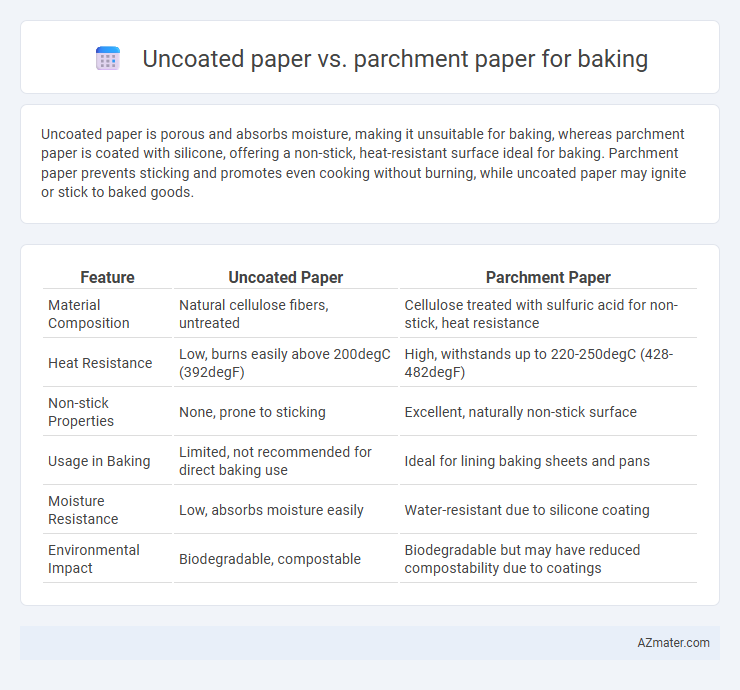Uncoated paper is porous and absorbs moisture, making it unsuitable for baking, whereas parchment paper is coated with silicone, offering a non-stick, heat-resistant surface ideal for baking. Parchment paper prevents sticking and promotes even cooking without burning, while uncoated paper may ignite or stick to baked goods.
Table of Comparison
| Feature | Uncoated Paper | Parchment Paper |
|---|---|---|
| Material Composition | Natural cellulose fibers, untreated | Cellulose treated with sulfuric acid for non-stick, heat resistance |
| Heat Resistance | Low, burns easily above 200degC (392degF) | High, withstands up to 220-250degC (428-482degF) |
| Non-stick Properties | None, prone to sticking | Excellent, naturally non-stick surface |
| Usage in Baking | Limited, not recommended for direct baking use | Ideal for lining baking sheets and pans |
| Moisture Resistance | Low, absorbs moisture easily | Water-resistant due to silicone coating |
| Environmental Impact | Biodegradable, compostable | Biodegradable but may have reduced compostability due to coatings |
Introduction: Uncoated Paper vs Parchment Paper
Uncoated paper lacks any coating, making it less resistant to grease and moisture compared to parchment paper, which is specifically treated with a silicone coating to provide non-stick, heat-resistant qualities ideal for baking. Parchment paper withstands high oven temperatures, prevents food from sticking, and simplifies cleanup, whereas uncoated paper may burn or absorb oils during baking. Choosing parchment paper ensures reliable non-stick performance and durability in a baking environment, whereas uncoated paper is better suited for food wrapping or light use.
What is Uncoated Paper?
Uncoated paper is an untreated, natural paper without any added chemical coatings, making it breathable and eco-friendly for baking purposes. Unlike parchment paper, which has a silicone or grease-resistant coating, uncoated paper allows moisture to pass through, often requiring greasing or oiling to prevent sticking. Its porous texture is ideal for tasks like wrapping baked goods or lining pans where non-stick properties are not crucial.
What is Parchment Paper?
Parchment paper is a cellulose-based baking material coated with silicone to provide a non-stick, heat-resistant surface ideal for baking and cooking. Unlike uncoated paper, parchment paper withstands high temperatures up to 420degF (215degC) without burning or sticking to food. Its moisture-resistant and grease-proof properties make it essential for tasks like lining baking trays and wrapping foods for even cooking.
Heat Resistance and Safety Comparisons
Uncoated paper and parchment paper differ significantly in heat resistance and safety for baking, with parchment paper typically rated to withstand temperatures up to 420-450degF due to its silicone or other heat-resistant coatings. Uncoated paper lacks this protective layer, making it prone to scorching or combustion at lower temperatures, generally unsuitable for baking applications. Parchment paper ensures food safety by preventing direct contact between baked goods and hot surfaces, reducing the risk of sticking and chemical exposure, while uncoated paper may release harmful substances or deteriorate under heat stress.
Baking Performance: Stickiness and Release
Uncoated paper tends to have higher stickiness, making it less ideal for baking as baked goods often adhere to its surface, complicating removal. Parchment paper features a silicone coating that provides superior non-stick properties, allowing baked items to release effortlessly without the need for additional grease or flour. This release quality enhances baking performance by reducing product damage and ensuring consistent browning and texture.
Impact on Texture and Browning
Uncoated paper allows more direct heat transfer, resulting in crispier edges and a more pronounced browning effect on baked goods. Parchment paper's silicone coating creates a non-stick surface that promotes even baking and prevents excessive browning, maintaining a softer texture. Choosing between uncoated and parchment paper significantly influences the crust development and moisture retention in cookies, pastries, and breads.
Suitability for Different Baking Recipes
Uncoated paper offers excellent moisture absorption and breathability, making it ideal for baking delicate pastries and cookies that require a crisp texture. Parchment paper is coated with a silicone layer, providing non-stick properties and heat resistance, which suits recipes like cakes, bread, and roasting where easy release and even cooking are essential. Choosing between uncoated and parchment paper depends on the recipe's moisture levels and the need for non-stick surfaces to ensure optimal baking results.
Reusability and Environmental Considerations
Uncoated paper offers limited reusability due to its tendency to absorb oils and degrade quickly, making it less environmentally sustainable over multiple uses. Parchment paper, often silicone-coated, provides better durability and non-stick properties, allowing it to be reused several times, which reduces waste. However, the silicone coating in parchment paper raises concerns about biodegradability, while uncoated paper, being compostable, presents a greener disposal option despite its single-use nature.
Cost and Availability Comparison
Uncoated paper, generally less expensive and widely available in grocery stores and online, offers a budget-friendly option for baking needs but may lack the non-stick properties of parchment paper. Parchment paper typically costs more due to its silicone coating, which provides superior non-stick performance and heat resistance, making it a preferred choice for consistent baking results. Both papers are accessible, but uncoated paper is more commonly found in bulk at lower prices, while parchment paper is often sold in specialized retail formats catering to baking enthusiasts and professionals.
Final Verdict: Which Paper Should You Use for Baking?
Uncoated paper, often made from natural fibers without additional coatings, offers a versatile and eco-friendly option for baking that prevents sticking and allows for even heat distribution. Parchment paper, coated with silicone, provides superior non-stick properties and heat resistance, making it ideal for baking cookies, pastries, and roasting vegetables. For the best baking results, parchment paper is generally preferred due to its durability and consistent non-stick performance, while uncoated paper suits lower-temperature applications or when chemical-free options are desired.

Infographic: Uncoated paper vs Parchment paper for Baking
 azmater.com
azmater.com